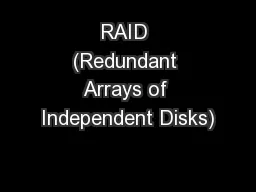

RAID Redundant Arrays of Independent Disks Disk organization technique that manages a large number of disks providing a view of a single disk of High capacity and high speed up using multiple disk in parallel ID: 379137
Download Presentation The PPT/PDF document "RAID (Redundant Arrays of Independent Di..." is the property of its rightful owner. Permission is granted to download and print the materials on this web site for personal, non-commercial use only, and to display it on your personal computer provided you do not modify the materials and that you retain all copyright notices contained in the materials. By downloading content from our website, you accept the terms of this agreement.
Slide1
RAID (Redundant Arrays of Independent Disks)Slide2
RAID (Redundant Arrays of Independent Disks)
Disk
organization technique that manages a large number of disks, providing a view of a single disk of
High capacity and high speed up using multiple disk in parallel
High reliability by storing data redundantly, so that can
recorded even if a disk fails
The
chance that some disk out of a set of N disks will fail is much higher than the chance that a specific single disk will fail.
It
is an cost effective alternative to large expensive disks. The I in Raid which now stands for
“Independent”
but originally stood for
“inexpensive
”Slide3
Improvement of Reliability via Redundancy
Redundancy
store extra information
that is not needed normally, but that can be used in the event of
failure of a disk to rebuild the lost information
.
Mirroring (or Shadowing)
:
The simplest approach to introduce redundancy is to
duplicate every disk
.
Logical
disk consists of 2 physical disks. Every write is carried out on both disks.
If one of the disk fails, the data can be read from the other
. Data will be lost only if the second disk fails before the first disk is repaired.
Mean
time to data loss depends on mean time to failure and mean time to repair.Slide4
Improvement in performance via parallelism
Two main goals of parallelism in a disk system are
Load balance multiple small accesses to increase
thoughput
.
Parallelize large accesses to reduce response time.
Improve transfer rate by striping data across multiple disks.
Bit-level striping
Split the bits of each byte across multiple disks
Block level striping
Requests for
different blocks can run in parallel if the blocks reside on different disks.Slide5
RAID LEVELS
To provide redundancy at lower cost by combining disk striping with ‘parity’ bits
Different RAID levels have different cost, performance and reliability characteristics.
In the diagrams,
P-indicates error correcting bits
,
C-indicates second copy of the data
.Slide6
RAID Level 0 : Non redundant block striping.
Used in high performance applications where data lost is not critical
Non redundant striping with array size 4Slide7
RAID Level 1 :
Mirrored disks with block striping
Offers best write performance
Popular for applications such as storing log files in a database systemSlide8
RAID level 2 :
Memory style error correcting codes (ECC) with bit striping.Slide9
RAID Level 3 : Bit –interleaved ParitySlide10
RAID Level 3 : Bit –interleaved
Parity cont…
A
single parity bit is enough for error correction
, not just detection, since we know which disk has failed.
When writing data, corresponding parity bits must be computed and written to a parity bit disk.
To recover data in a damaged disk, compute XOR of bits from other disks.
Faster data transfer than with a single disk, but fewer I/Os per second since every disk has to participate in every I/O.Slide11
RAID Level 4: Block interleaved paritySlide12
RAID Level 4: Block interleaved parity
Uses block level striping, and keeps a parity block on a separate disk for corresponding blocks from N other disks.
Provides higher I/O rates for independent reads than level 3
Block read goes to a single disk, so blocks stored on different disks can be read in parallel.
Provides higher rates for reads of multiple blocks than no striping.
Before writing a block, parity data must be computed.
More efficient for writing large amount of data sequentially.Slide13
RAID Level 5 Block interleaved distributed parity.Slide14
RAID Level 5 Block interleaved distributed parity.
Partions
data and parity among all N+1 disks, rather than storing data in N disks and parity in disk.
Eg
: With 5 disks, parity block for nth set of blocks is stored on disk (n mod 5) +1, with the data blocks stored on the other 4 disks.
Higher I/O rates than level 4.Block writes occur in parallel if the blocks and their parity blocks are on different disks.Slide15
RAID Level 6 : P+Q Redundancy SchemeSlide16
RAID Level 6 : P+Q Redundancy Scheme
Similar to level 5, but stores
extre
redundant information
to guard against multiple disk failures.
Better reliability than level 5 at a higher cost, but not used as widely
.Slide17
Choice of RAID level
Factors in choosing RAID level
Monetary cost
Performance : Number of
i
/p operations per second, band width during normal operationPerformance during failurePerformance during rebuild of failed disk
RAID 0
is used only when
data safety is not important
Level 2 and 4 never used
, since they are subsumed by 3 and 5
Level 3 is not used
anywhere since bit-striping forces single block reads to access all disks, wasting disk arm movement.
Level 6 is rarely used
since
level1 and 5 offer adequate safety for almost all applications
.
So competition is between 1 and 5 only.
Level 1 provides for applications with low update rate and large amounts of data
.
Level 1 is preferred for all other applications
.